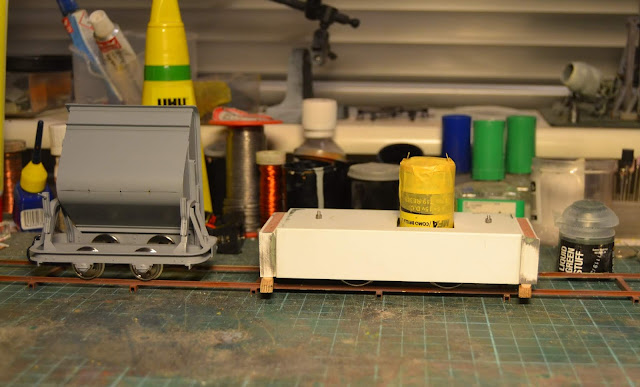I haven't had much time for modelling lately. But I have managed to adjust the 'sit' of the plasticcard frame on the power bogie by fixing layers of plasticcard cut offs inside the frame. There may still be some minor adjusting to do, but the frame's height above top of rail is almost right. The frame's edges and corners were worked with sanding sticks and sand paper. The rounded appearance of a Pedershaab frame is now almost there. The ballast weights to be fitted on each end were made from plasticcard and Miliput. Sanding produced smooth rectangles of fairly square shapes.
 |
| Pedershaab frame with ballast weights still unglued. The skip to left has had three holes drilled in the bottom. The holes were drilled to test how best to drill through the quite tough metal body. |
The D-series of Pedershaab locos I'm
building a model of all seem very uniform at first glance, but once you
get closer they exhibit all sorts of differencies. I'm not building one
particular loco but a wartime built model FD with large ballast plates
resembling the preserved M 2 on HVB.
Below is a series of images from a user of a large number of Pedershaab locos clearly showing their variety and important work. During the German occupation of Denmark 1940-1945 every part of society was lacking ressources. The Danish cement producing industry was cut off from its usual coal supplies and what little Germany could provide didn't meet the needs. Consequently the cement industry sought new types of fuel. In the large peat bogs south and north of the cement industry's epicenter in Aalborg the companies began harvesting peat to burn in the cement ovens. The peat extraction was a huge operation using a large number of machines, considerable manpower and both narrow and standard gauge railways.
 |
| Open cab Pedershaab no. 15 positioning wagons for loading at a peat excavator. No 15 was powered by natural gas to save on the limited amount of petrol available. The gas was extracted from local underground deposits by drilled shafts and delivered in pressurized tanks to the users. |
 |
| Workers getting a ride on a Pedershaab on their way to work. Could I perhaps completely skip modelling the top part of my Pedershaab and just fit 12-14 scale figures? |
 |
| Pedershaab fitted with a snow plough posing between heaps of peat. Notice the black out fitting on the front lamp. It was war time and a nationwide black out was in force to make navigation for allied bombers as difficult as possible. |
 |
| Pedershaab no. 13 equipped for fire fighting duties. No 13 is fitted with netting over the exhaust to prevent igniting the highly flammable peat bog. The netting couldn't catch every ember from the exhaust pipe, but was reasonably effective preventing bog fires. |
 |
| Pedershaab no. 3 with pressurized tank for natural gas and closed cab on the large ramp used for loading lorries as well as standard gauge wagons. |
 |
| Last image is a great line up of 15 700 mm gauge locomotives. 13 from Pedershaab and 2 locos from Kastrup Machineworks. All locos seem to be fitted with natural gas fueled engines. |
The series of images can be found on the great public
Danish online archive arkiv.dk to be viewed for free. The website is a great ressource when modelling Danish prototypes.








Great project Claus, and I love the prototype photos, it looks a characterful little engine!
ReplyDelete